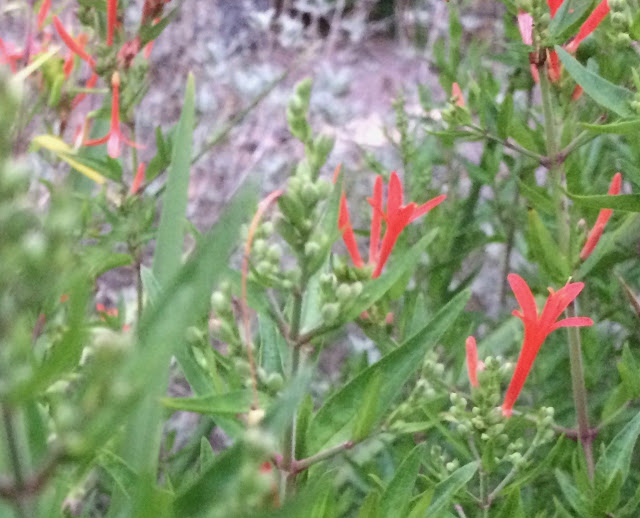Anisacanthus buds S. Reeve
It takes hard pruning really easily, and it improves the growth habit by making it fuller after pruning. Feel free to prune it to the ground in the late winter, and it will reward you with dense fresh new growth and abundant flowers all through the summer. Pruning does improve the growth habit, as it can be a little sparse on top and unruly if left to its own devices. The skinny foliage is a nice rich green that doesn't appear to suffer in the slightest bit when the temperatures rocket upward. Drought tolerant too as I have some that get no irrigation and they do just fine. A little water does mean more flowers for a longer period of time though. While it is native to dry limestone soils in Texas and Mexico, it is adaptable to other conditions. Like other Texas plants, it responds well to water in the summer with profuse flushes of new blooms. Hardy to 10 degrees F. Speaking of adaptability, Tony Avent does sell this plant at his Raleigh, NC nursery, Plant Delights. I ordered it several times to grow in my Zone 8 Athens, GA garden but it never survived in spite of me desperately wanting it to. Supposedly it grows in Houston, but it did not grow in Athens, GA. Not sure why the difference?
Anisacanthus quadrifidus var. wrightii S. Reeve
It will even grow in a little shade. It does not need full sun to bloom well, but it blooms better in full sun with additional water. As you can see the flowers are made for hummingbirds and they get lots of visitors! The petals and sepals are both fused into a tube at the base. The petals open out into four lobes that irresistibly invite hummingbirds to dine. Anisacanthus is in the Acanthaceae Family which also includes Justicias and Thunbergias--other hummingbird pollinated genera. One characteristic of Acanthaceae that is unusual is the opposite arrangement of leaves. Not too many plants have opposite leaves.
Photo of the jaculator the little prong on the right side of the seed. Photo by Hugh Wilson
Another characteristic of these plants that I am not too pleased with is its exploding brown seed capsules that launch seeds several feet away. Mind you, not a bad strategy for increasing the population, but many of these seeds sprout, so you need to be ruthless about weeding them out as you see them. These are a little blurry but they show the seed capsule beginning to form. This is the little club-like structure with the filament coming out of the end.
S. Reeve
Seed capsules S. Reeve
Now that I have rabbits in my yard the seedlings are less of a problem because the rabbits love to eat new young plants. The mechanism that flings the seeds is called a "jaculator." It is a rigid hook-shaped structure or modified funiculus that catapults the seeds from the plant. A funiculus is a plant structure that attaches the ovule to the placenta, and that is generally its main function, but in the case of this plant, this funiculus also functions as a jaculator propelling black seeds after the brown capsule explosively opens.
Anisacanthus quadrifidus var. wrightii blooms S. Reeve






No comments:
Post a Comment
Please like, subscribe, and comment